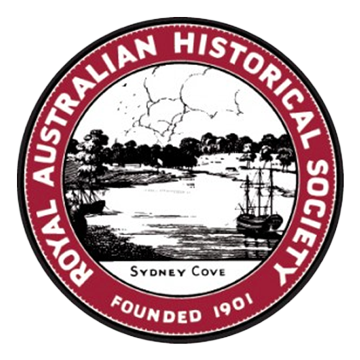RAHS Library Collections
The RAHS Library houses a significant research collection of more than 62,000 items on Australian history. The Library specialises in New South Wales local and community history and includes an extensive range of written and pictorial resources.
More than 25,000 items are now searchable through the test version of our new online catalogue, making it easier for researchers to explore part of the collection remotely. New records are added regularly as we continue cataloguing the collection.
The remainder of the collection is searchable through the Library’s internal database. If you are looking for resources not yet available online, please contact the RAHS Librarian for assistance at library@rahs.org.au or to arrange a visit to the Library.
RAHS Collections discoverable on our online catalogue
Your Title Goes Here
Books, including RAHS Rare Books Collection
About the Collection
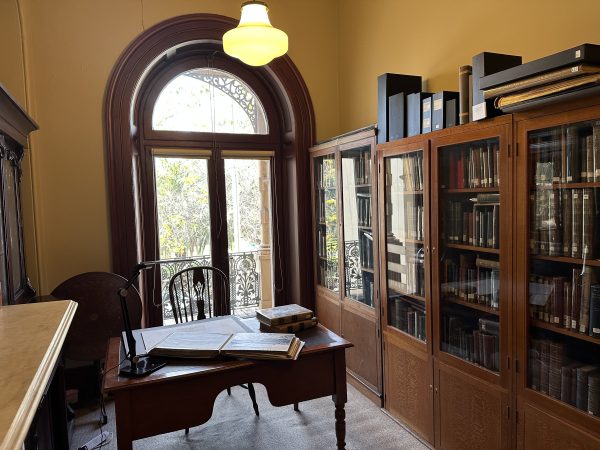
RAHS Rare Books Room, History House, Level 1
The RAHS Library holds a significant book collection specialising in Australian history, with a particular focus on the histories of New South Wales communities and places. The collection spans over a century of acquisitions and donations, reflecting the evolving interests of historians, researchers, and local communities.
A key part of the collection is the wide range of publications produced by RAHS Affiliated Societies, which provide unique insights into local and community histories across New South Wales. Many of these works were created through community history projects, some funded by grants administered by the RAHS on behalf of the NSW Government. These publications are often produced in limited print runs, making them difficult to find elsewhere. The RAHS Library holds one of the most comprehensive collections of these publications, ensuring they remain accessible to researchers at History House.
The Library also holds a Rare Book Collection of 1,350 works dating from the early to mid-19th century. This collection includes first editions, pamphlets, family bibles, early travel accounts, and other historically significant publications. Its value lies not only in the rarity of individual items but also in their provenance – the documented history of ownership and use that provides insight into the book’s origins, previous custodians, and cultural context. Many items were donated by prominent historians and RAHS members, linking the collection to the broader story of historical scholarship in New South Wales.
RAHS Periodicals and RAHS Conference Proceedings
About the Collection
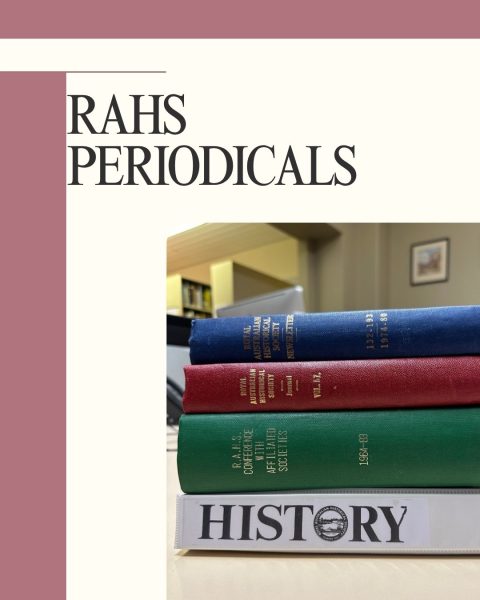 The Journal of the Royal Australian Historical Society (JRAHS), first published in 1906, is one of Australia’s longest-running historical journals. It features peer-reviewed articles covering a wide range of topics – from colonial settlement and local histories to broader social and cultural themes. The Journal remains an essential resource for researchers and anyone interested in Australian history.
The Journal of the Royal Australian Historical Society (JRAHS), first published in 1906, is one of Australia’s longest-running historical journals. It features peer-reviewed articles covering a wide range of topics – from colonial settlement and local histories to broader social and cultural themes. The Journal remains an essential resource for researchers and anyone interested in Australian history.
History magazine was launched in 1988, building on the earlier RAHS Newsletter. While the newsletter focused on news and updates, History expanded to include feature articles, stories from affiliated societies, and highlights of community history projects. Both publications reflect the Society’s long-standing commitment to sharing historical knowledge in an engaging and accessible way.
The Library also holds a collection of RAHS Conference Proceedings, covering RAHS Conferences held from 1964 to 1995. These annual events brought together professional and community historians to share research, ideas, and approaches to storytelling. The preserved papers offer a valuable record of how ideas, research interests, and approaches to history have evolved in New South Wales over the past three decades.
Together, these publications reflect the RAHS’s ongoing role in supporting and sharing historical research across the state.
Affiliated Societies Serials Collection
About the Collection
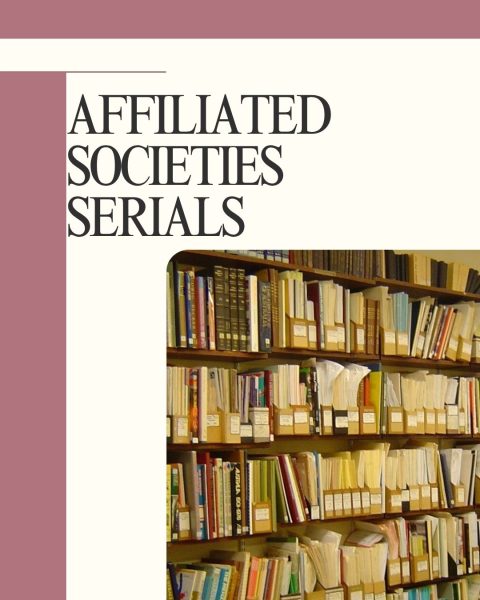 Since 1935, the RAHS has welcomed affiliated societies as members and has actively collected their serials and publications. The Library’s Affiliated Societies Serials Collection offers unique perspectives that enrich our understanding of local and community history in New South Wales. Drawing on their own archives and local records, affiliated societies document people, places, and events, producing publications that contain overlooked details and hidden insights for researchers exploring Australia’s past.
Since 1935, the RAHS has welcomed affiliated societies as members and has actively collected their serials and publications. The Library’s Affiliated Societies Serials Collection offers unique perspectives that enrich our understanding of local and community history in New South Wales. Drawing on their own archives and local records, affiliated societies document people, places, and events, producing publications that contain overlooked details and hidden insights for researchers exploring Australia’s past.
The RAHS Library holds more than 500 affiliated society serial titles, representing both past and current affiliated societies. It is recognised as a State repository for this material.
These serials form a distinctive archive of local history, capturing the voices, concerns, and interests of communities across New South Wales over nearly a century. They reflect the evolving priorities of local historians, often featuring photographs, community histories, and personal stories that are unlikely to be found in mainstream publications. The collection offers rich, ground-level perspectives on social change, built heritage, and everyday life, particularly during the rise in interest in local and family history during the 1960s and 1970s. This focus on community life and connection to the past continues to shape each publication.
Formats vary widely and include folded A5 newsletters, stapled A4 bulletins, loose-leaf photocopies, digital files, and bound journals of up to 30 pages. Some serials have been bound by the societies themselves or by the RAHS for long-term preservation.
The catalogue lists the serial titles held, but it does not include an index of individual articles. Some titles have been indexed, and the database containing these indexes is available onsite at History House. We recommend visiting or contacting the RAHS Librarian, Donna Newton, at library@rahs.org.au for assistance with accessing this valuable collection.
Other Serials
About the Collection
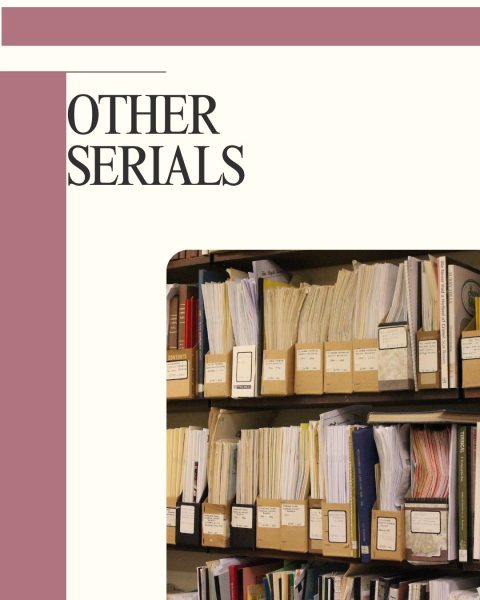 In addition to the extensive collection of serials published by affiliated societies, the RAHS Library holds a wide range of serial publications produced by other historical and heritage organisations, specialist groups, and private entities across Australia.
In addition to the extensive collection of serials published by affiliated societies, the RAHS Library holds a wide range of serial publications produced by other historical and heritage organisations, specialist groups, and private entities across Australia.
While some early material is included, most of the collection dates from the 1960s and 1970s – a period of renewed interest in documenting local, cultural, and industrial histories. The serials vary in format, from single-sheet newsletters and folded bulletins to bound journals and digital publications. Many early issues have been professionally or locally bound for long-term preservation.
These serials offer valuable insights into specific communities, professions, and cultural movements, often capturing perspectives and histories that are otherwise underrepresented. They are regularly accessed by researchers and library visitors seeking content not widely held elsewhere.
Some serials have been indexed in a searchable database available onsite at History House. In future, we plan to expand this index and integrate it with our online catalogue to improve access for researchers.
Library visitors are welcome to browse these serials during opening hours. For further information or assistance, please contact the RAHS Librarian, Donna Newton, at library@rahs.org.au.
The Walker Collection: Books (other items, including manuscripts, photographs, scrapbooks and glass slides, to be added to online catalogue)
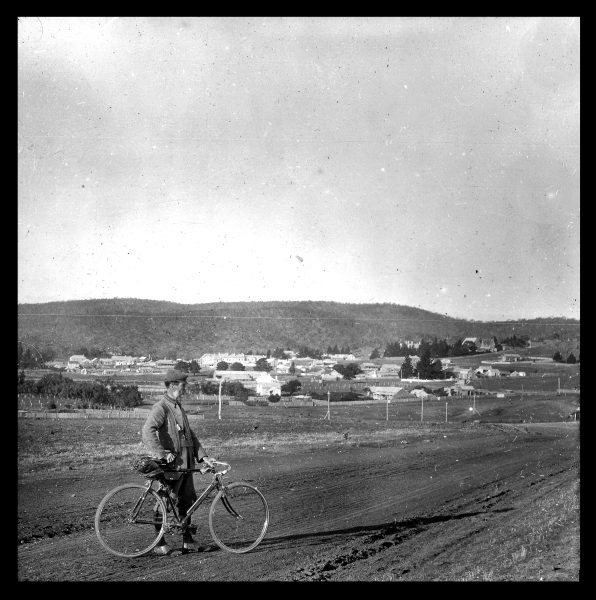
Frank Walker looking over view of Cooma, 1906 (RAHS Walker Collection)
Frank Walker (1861–1948) was a founding member of the RAHS, serving as its President from 1912 to 1913 and as the Society’s first Honorary Librarian from 1917 to 1920. A dedicated historian, photographer, and cyclist, Walker travelled more than 27,000 miles by bicycle between 1895 and 1908 across New South Wales, Victoria, and Tasmania. During these travels, he created an extensive visual record using glass slide photography to document towns, landscapes, buildings, and daily life.
Walker shared his work through illustrated lantern lectures at the Society and contributed 18 articles to the Journal of the Royal Australian Historical Society. His commitment to collecting and sharing history helped lay the foundations for the RAHS’s enduring goal: to promote the understanding and appreciation of Australian history.
About the Walker Collection
This collection is a cornerstone of our archival holdings, offering a vivid visual and documentary record of New South Wales and beyond during the late 19th and early 20th centuries. It includes over 200 photographs, 2,000 glass slides, 48 manuscripts, 43 books, and a series of meticulously compiled scrapbooks.
This collection is an invaluable resource for researchers interested in Australian social, regional, and cultural history. Walker’s photographs and glass slides provide rich visual evidence of life in country towns and on the roads of New South Wales, while his manuscripts and lectures offer contextual detail and commentary. Researchers examining themes such as settlement patterns, rural infrastructure, exploration, early tourism, and local identity will find the collection particularly useful. It also includes material on the Great Roads of northern, southern, and western New South Wales, as well as the early history of key districts in New South Wales, Victoria, and Norfolk Island.
Foster Collection: Books (other items, including photographs, scrapbooks and glass slides, to be added to online catalogue)
We all realise how rapidly the old is giving place to the new, and only by means of pictures will those who come after us know what Sydney was like once upon a time. And in looking at pictures of quiet streets, quaint old homes, beautiful gardens and fine old trees, they will understand why many today still call this queenly city ‘Dear old Sydney’ – Mrs A.G. Foster, Odd Bits of Old Sydney (1921)
About the Fosters
Married couple Josephine Ethel Foster (1870-1955) and Arthur George Foster (1861-1924) shared a passion for photography and Australian history. Arthur and Ethel were among the first members to join the Australian Historical Society (later RAHS) in 1901. They were awarded RAHS Fellowships in 1921 and 1924, respectively, to honour their contributions to the organisation and Australian history.
They were among the earliest members of the Australian Historical Society (later the Royal Australian Historical Society), joining in its founding year, 1901. In recognition of their significant contributions to the Society and to the preservation of Australian history, Arthur and Ethel were awarded RAHS Fellowships in 1921 and 1924, respectively.
The Fosters devoted their time and skills to documenting the transformation of Sydney, using photography to preserve the memory of buildings and sites destined for demolition. Their work is especially important for capturing traces of now-lost places, most notably Sydney’s Devonshire Street Cemetery.
In January 1901, the NSW Government announced plans to clear the Devonshire Street Cemetery to make way for Central Station. In response, the Fosters spent every weekend for two years documenting the site. They drew monuments, transcribed headstone inscriptions, and took photographs—preserving a detailed record before the remains were relocated. Their work has proven invaluable: the State Library of NSW’s 2019 exhibition Dead Central relied heavily on the Fosters’ documentation to explore the historical and cultural significance of the cemetery and its removal.
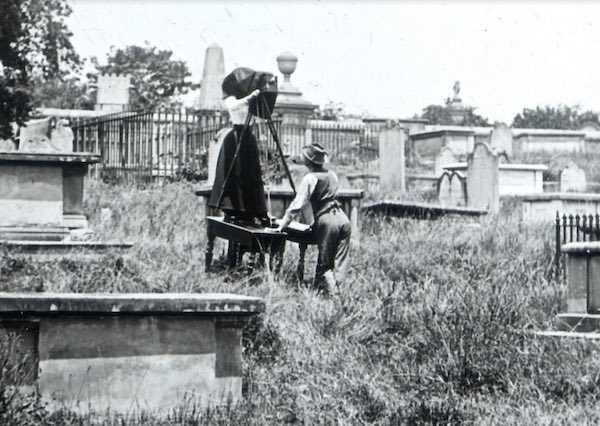
Mrs A.G. Foster taking photographs in the Devonshire Street Cemetery [RAHS Collection]
About the Foster Collection
After the death of Ethel Foster, the RAHS Library acquired her collection of over 250 books, 35 volumes of press clippings (scrapbooks) and 381 glass slides.
The scrapbook collections are a combination of Foster Press Clippings and Pamphlets. Assembled between the 1880s and 1930s, these 51 volumes highlight important historical events, as well as the social history of NSW. They include newspaper clippings, souvenir booklets and small monographs, invoices and accounts, handwritten correspondence, lists, plans and notes, postcards and photographs, rail and tram tickets and invitations. The contents of the scrapbooks are a reflection of Sydney’s history and also relate to what happened in Ethel Foster’s life at the time.
The glass slides collection features 381 slides of early Sydney and 70 rare photographs of the Sandhills Cemetery, which accompanied ‘The Sandhills: An Historic Cemetery’ by A.G. Foster, read before the Society in 1918.
The photograph collection contains images of early Sydney, landmarks and buildings and three bound volumes containing 75 prints from the Devonshire Street/Central Station project.
The Foster Collection provides a rich and layered resource for researchers interested in Sydney’s urban development, public memory, and everyday life from the late 19th to early 20th century. The mix of visual material, personal records, and ephemeral items offers rare insights into how individuals and communities documented and responded to change
References
Elise Edmonds, ‘Dead Central,’ State Library of NSW, https://www.sl.nsw.gov.au/stories/dead-central, accessed 24 January 2023.
A.G. Foster, Odd Bits of Sydney, Tyrrell’s, Ltd, Sydney 1921.
A.G. Foster, ‘The Sandhills: An historic cemetery’, JRAHS Vol. 5, Pt. 4, 1919, pp. 153-195.
Anne-Maree Whitaker, ‘Foster, Arthur George (1861–1924)’, People Australia, National Centre of Biography, Australian National University, http://peopleaustralia.anu.edu.au/biography/foster-arthur-george-27600/text34993, accessed 24 January 2023.
Anne-Maree Whitaker, ‘Foster, Josephine Ethel (1870–1955)’, People Australia, National Centre of Biography, Australian National University, http://peopleaustralia.anu.edu.au/biography/foster-josephine-ethel-27601/text34995, accessed 24 January 2023.
A profile on Ethel Foster is part of our Women’s History Month webpage.
Watson Collection: Books (other items, including photographs, scrapbooks and glass slides, to be added to online catalogue)
About Captain James Henry Watson
Born in Devonshire, England, Captain James Henry Watson (1841-1934) served with the British militia and was promoted to captain in the 1st Infantry Regiment, New South Wales, in 1889, later resigning his command in 1892. As well as his military service, Watson had a varied business career. He worked in Victoria, England and India, including time spent in the service of the Great Indian Peninsula Railway Co. In 1880 he moved to Sydney to become a department manager for David Jones. He used the business skills he learnt from his employers to establish his own company in 1889 – Beard, Watson & Co., carpet warehousemen.
After his successful business career, Watson retired in 1901 to become a significant contributor to Australian history. He joined the RAHS (then Australian Historical Society) in 1904 and immersed himself in Australian history research, answering members’ family and local history queries and exploring cemeteries for genealogical information. Watson’s research interests included the history of churches, shipping and early Australian towns and families. He had twenty-nine papers published in the Journal of the Royal Australian Historical Society on his favourite topics.
In 1916, Watson received a RAHS Fellowship to honour his contribution to the organisation and Australian history. He served as President in 1909, 1926 and 1927. Businessman and historian Watson was also known as a style icon of his time:
… his erect figure and springy step as he passed along the city streets being the envy and admiration of those who knew him. – Oddfellows Magazine, 15 June 1930
About the Watson Collection
The Watson Collection is a rich resource for researchers interested in early New South Wales history, local heritage, and the development of historical inquiry in Australia. It reflects Captain James Henry Watson’s wide-ranging interests and meticulous approach to historical research.
The collection includes 230 glass lantern slides depicting early NSW scenes; 32 volumes of press clippings containing newspaper cuttings, historical papers, and photographs; 20 manuscripts; and 80 photographs of the Sydney region and RAHS excursions. These materials provide valuable insights into how history was studied, recorded, and shared in the early 20th century.
The collection also features over 60 books, including rare and significant works such as a first edition of David Collins’ An Account of the English Colony in New South Wales (1798) and William Wells’ A Geographical Dictionary (1848), reflecting Watson’s commitment to sourcing original and authoritative historical sources.
In 2002, the RAHS acquired a 193-page journal documenting Watson’s participation in Society excursions between 1924 and 1926. This volume contains photographs, correspondence, typed and handwritten accounts, maps, newspaper clippings, and a list of participants—offering a vivid snapshot of how early RAHS members engaged with historical places and shared their knowledge.
Together, these materials offer researchers a unique window into early historical scholarship, the preservation of NSW history, and the active role Watson played in shaping public engagement with Australia’s past.
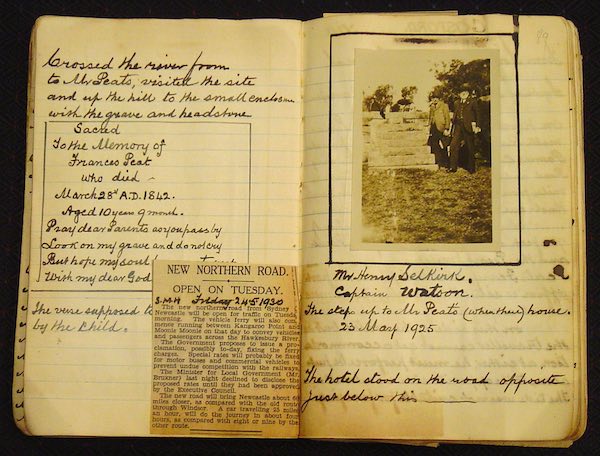
James Henry Watson’s ‘Excursion Journal’ [RAHS Collection]
References
K.R. Cramp, ‘Captain J.H. Watson. A Life Sketch and an Appreciation’, JRAHS Vol. 20, Pt. 6 (1934): pp. 432-439.
Ian Jack, ‘From the Presidential Desk’, History Magazine, Jun. 2004.
Diane Langmore, ‘Watson, James Henry (1841–1934)’, Australian Dictionary of Biography, National Centre of Biography, Australian National University, http://adb.anu.edu.au/biography/watson-james-henry-9002/text15773, published first in hardcopy 1990, accessed online 24 January 2023.
Oddfellows Magazine, 15 June 1930.
Photographs: Adastra Aerial Survey Collection – primarily aerial photographs of Sydney and NSW south coast from 1936 to 1938
About Adastra Airways Pty Ltd
In 1930, Captain Frank William Follett (1892-1950) and Henry Talbot Hammond (1894-1982), a fellow First World War veteran, founded Adastra Airways Pty. Ltd. Both men had served in the Australian Flying Corps and worked as flying instructors after the war.
Frank’s younger sister, Evelyn Mary Follett (1902-1977), was also a founding director of the company. Evelyn, the third woman in Australia to obtain a private pilot licence, was one of six women pilots who provided an aerial escort for British aviator Amy Johnson when she arrived in Sydney on 4 June 1930.
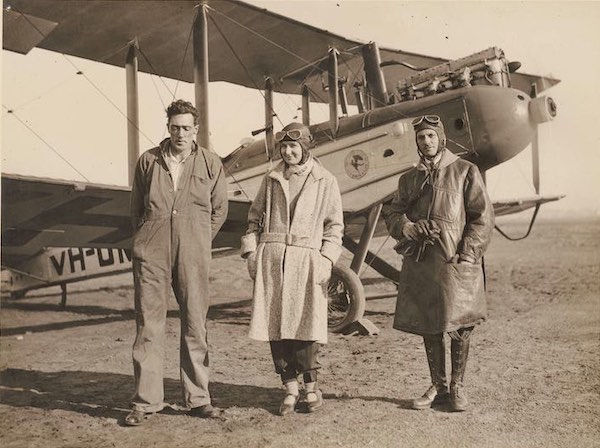
Two of Adastra’s founders, Miss Evelyn Follett (centre) and her brother, Captain Frank Follett (right), pose with an unknown engineer and an Aero Club of New South Wales Airco DH-9 (The Hood Collection, SLNSW, ML ref. PXE 789 vol. 6 no. 43)
Adastra began as a flying school at Mascot Aerodrome, now the Sydney (Kingsford Smith) International Airport. In addition, it operated a regular airline service between Sydney and Bega and became known as a pioneering company in civilian aerial photographic surveys. In 1939, Frank Follett left Australia to study the latest techniques in aerial photography in England, the Netherlands, Switzerland and Germany, returning to Australia just before the outbreak of World War II.
Adastra’s aerial surveys, which captured Australia’s post-war development, are a unique historical resource. During the Second World War, Adastra was the only private company to participate in an emergency program to map Australia. At the end of the war, the company continued to receive government contracts, including one to survey the entire Darling River. Due to financial difficulties, Adastra was purchased by East-West Airlines on 1 April 1973 and then shortly ceased operating.
About the Adastra Aerial Survey Collection
The Wyong Museum and Wyong Historical Society donated the collection in 2011, a few months before an arsonist almost destroyed historic Alison Homestead, where the museum stored and displayed its collection. This collection is a series of approximately two hundred negatives and glass plate images from 1936 to 1938, primarily aerial photographs of Sydney and the south coast of New South Wales. It also includes thirty aerial images of Port Moresby. Most of the photographs were taken by Frank Follett, Peter Payens (1914-1994) and Lesley Charles Gordon Lavender (1905-1994). A selection of images from the collection can be viewed on the RAHS Flickr or by contacting the librarian. The State Library of NSW and National Library of Australia collections also hold items related to Adastra Airways.
References
Ron Cuskelly, ADASTRA Aerial Surveys: The story of the company, its aircraft and its people [electronic resource], 2003, http://nla.gov.au/nla.arc-41516, accessed 13 October 2020.
Henry Hammond & Mel Pratt, Henry Talbot Hammond interviewed by Mel Pratt for the Mel Pratt collection [sound recording], 1974, http://nla.gov.au/nla.obj-214893317, accessed 13 October 2020.
Sheila Mann & Department of Aviation, Australia, The girls were up there too: Australian women in aviation (Department of Aviation Australian Government Publishing Service Canberra, 1986).
Phil Morley, ‘Arson attack razes Alison Homestead’, Wyong District Pioneers Association, https://alisonhomestead.wordpress.com/2011/12/10/arson-attack-razes-alison-homestead/, accessed 30 September 2020.
Colin Simpson, ‘As Seen From the Skyway’, The Sun, 22 January 1933, p. 17.
G.P. Walsh, ‘Follett, Frank William (1892–1950)’, Australian Dictionary of Biography, National Centre of Biography, Australian National University, http://adb.anu.edu.au/biography/follett-frank-william-6203/text10661, published first in hardcopy 1981, accessed online 29 September 2020.
Photographs: Osborne Collection – primarily images of City of Sydney and surrounding suburbs from 1920 to late 1930s
About the Collection
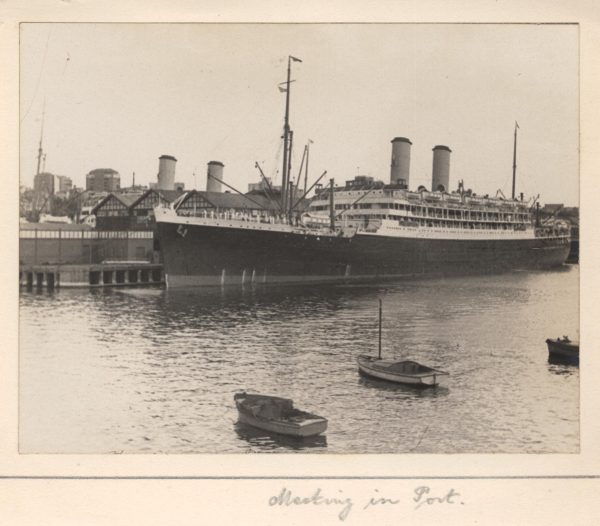 The Osborne Collection comprises more than 400 photographs taken between the early 1920s and late 1930s. Donated to the RAHS in 2011 by Lyle and Jennie Osborne, the photographs had been carefully stored in their Narellan Vale family home for over two decades. As they prepared to move house, the Osbornes recognised the collection’s cultural and historical value and offered it to the RAHS, where it has been preserved ever since.
The Osborne Collection comprises more than 400 photographs taken between the early 1920s and late 1930s. Donated to the RAHS in 2011 by Lyle and Jennie Osborne, the photographs had been carefully stored in their Narellan Vale family home for over two decades. As they prepared to move house, the Osbornes recognised the collection’s cultural and historical value and offered it to the RAHS, where it has been preserved ever since.
The photographer behind the lens remains unknown, but their eye for detail and poetic sensibility is evident throughout. Capturing life in the City of Sydney and nearby areas – including the eastern suburbs, Newcastle, the Illawarra, and the Central Coast – the images offer a striking visual record of interwar New South Wales. One album extends further afield, featuring scenes from Tenterfield, Inverell, Picton, Boohoo Boonoo Gorge, Brisbane, and even Malaysia.
Originally housed in seven albums, the photographs include portraits, streetscapes, and landscapes. Many are titled with imaginative captions – Sydney’s newly completed Harbour Bridge, for example, is named A Symphony in Steel. The Osborne Collection offers a rich and evocative window into the people and places of a rapidly changing era.
References
Graham Sciberras, ‘A gift of opportunity – the Osborne Collection’, History Magazine, Sept. 2014.
